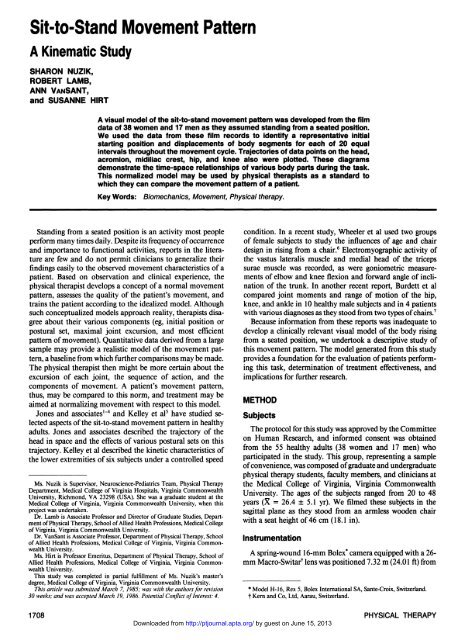Sit-to-Stand Movement Pattern A Kinematic Study - Physical Therapy
Sit-to-Stand Movement Pattern A Kinematic Study - Physical Therapy
Sit-to-Stand Movement Pattern A Kinematic Study - Physical Therapy
You also want an ePaper? Increase the reach of your titles
YUMPU automatically turns print PDFs into web optimized ePapers that Google loves.
<strong>Sit</strong>-<strong>to</strong>-<strong>Stand</strong> <strong>Movement</strong> <strong>Pattern</strong><br />
A <strong>Kinematic</strong> <strong>Study</strong><br />
SHARON NUZIK,<br />
ROBERT LAMB,<br />
ANN VANSANT,<br />
and SUSANNE HIRT<br />
A visual model of the sit-<strong>to</strong>-stand movement pattern was developed from the film<br />
data of 38 women and 17 men as they assumed standing from a seated position.<br />
We used the data from these film records <strong>to</strong> identify a representative initial<br />
starting position and displacements of body segments for each of 20 equal<br />
intervals throughout the movement cycle. Trajec<strong>to</strong>ries of data points on the head,<br />
acromion, midiliac crest, hip, and knee also were plotted. These diagrams<br />
demonstrate the time-space relationships of various body parts during the task.<br />
This normalized model may be used by physical therapists as a standard <strong>to</strong><br />
which they can compare the movement pattern of a patient.<br />
Key Words: Biomechanics, <strong>Movement</strong>, <strong>Physical</strong> therapy.<br />
<strong>Stand</strong>ing from a seated position is an activity most people<br />
perform many times daily. Despite its frequency of occurrence<br />
and importance <strong>to</strong> functional activities, reports in the literature<br />
are few and do not permit clinicians <strong>to</strong> generalize their<br />
findings easily <strong>to</strong> the observed movement characteristics of a<br />
patient. Based on observation and clinical experience, the<br />
physical therapist develops a concept of a normal movement<br />
pattern, assesses the quality of the patient's movement, and<br />
trains the patient according <strong>to</strong> the idealized model. Although<br />
such conceptualized models approach reality, therapists disagree<br />
about their various components (eg, initial position or<br />
postural set, maximal joint excursion, and most efficient<br />
pattern of movement). Quantitative data derived from a large<br />
sample may provide a realistic model of the movement pattern,<br />
a baseline from which further comparisons may be made.<br />
The physical therapist then might be more certain about the<br />
excursion of each joint, the sequence of action, and the<br />
components of movement. A patient's movement pattern,<br />
thus, may be compared <strong>to</strong> this norm, and treatment may be<br />
aimed at normalizing movement with respect <strong>to</strong> this model.<br />
Jones and associates 1-4 and Kelley et al 5 have studied selected<br />
aspects of the sit-<strong>to</strong>-stand movement pattern in healthy<br />
adults. Jones and associates described the trajec<strong>to</strong>ry of the<br />
head in space and the effects of various postural sets on this<br />
trajec<strong>to</strong>ry. Kelley et al described the kinetic characteristics of<br />
the lower extremities of six subjects under a controlled speed<br />
Ms. Nuzik is Supervisor, Neuroscience-Pediatrics Team, <strong>Physical</strong> <strong>Therapy</strong><br />
Department, Medical College of Virginia Hospitals, Virginia Commonwealth<br />
University, Richmond, VA 23298 (USA). She was a graduate student at the<br />
Medical College of Virginia, Virginia Commonwealth University, when this<br />
project was undertaken.<br />
Dr. Lamb is Associate Professor and Direc<strong>to</strong>r of Graduate Studies, Department<br />
of <strong>Physical</strong> <strong>Therapy</strong>, School of Allied Health Professions, Medical College<br />
of Virginia, Virginia Commonwealth University.<br />
Dr. VanSant is Associate Professor, Department of <strong>Physical</strong> <strong>Therapy</strong>, School<br />
of Allied Health Professions, Medical College of Virginia, Virginia Commonwealth<br />
University.<br />
Ms. Hirt is Professor Emeritus, Department of <strong>Physical</strong> <strong>Therapy</strong>, School of<br />
Allied Health Professions, Medical College of Virginia, Virginia Commonwealth<br />
University.<br />
This study was completed in partial fulfillment of Ms. Nuzik's master's<br />
degree, Medical College of Virginia, Virginia Commonwealth University.<br />
This article was submitted March 7, 1985; was with the authors for revision<br />
30 weeks; and was accepted March 19, 1986. Potential Conflict of Interest: 4.<br />
1708<br />
condition. In a recent study, Wheeler et al used two groups<br />
of female subjects <strong>to</strong> study the influences of age and chair<br />
design in rising from a chair. 6 Electromyographic activity of<br />
the vastus lateralis muscle and medial head of the triceps<br />
surae muscle was recorded, as were goniometric measurements<br />
of elbow and knee flexion and forward angle of inclination<br />
of the trunk. In another recent report, Burdett et al<br />
compared joint moments and range of motion of the hip,<br />
knee, and ankle in 10 healthy male subjects and in 4 patients<br />
with various diagnoses as they s<strong>to</strong>od from two types of chairs. 7<br />
Because information from these reports was inadequate <strong>to</strong><br />
develop a clinically relevant visual model of the body rising<br />
from a seated position, we under<strong>to</strong>ok a descriptive study of<br />
this movement pattern. The model generated from this study<br />
provides a foundation for the evaluation of patients performing<br />
this task, determination of treatment effectiveness, and<br />
implications for further research.<br />
METHOD<br />
Subjects<br />
The pro<strong>to</strong>col for this study was approved by the Committee<br />
on Human Research, and informed consent was obtained<br />
from the 55 healthy adults (38 women and 17 men) who<br />
participated in the study. This group, representing a sample<br />
of convenience, was composed of graduate and undergraduate<br />
physical therapy students, faculty members, and clinicians at<br />
the Medical College of Virginia, Virginia Commonwealth<br />
University. The ages of the subjects ranged from 20 <strong>to</strong> 48<br />
years ( = 26.4 ± 5.1 yr). We filmed these subjects in the<br />
sagittal plane as they s<strong>to</strong>od from an armless wooden chair<br />
with a seat height of 46 cm (18.1 in).<br />
Instrumentation<br />
Downloaded from<br />
http://ptjournal.apta.org/ by guest on June 15, 2013<br />
A spring-wound 16-mm Bolex* camera equipped with a 26mm<br />
Macro-Switar † lens was positioned 7.32 m (24.01 ft) from<br />
* Model H-16, Rex 5, Bolex International SA, Sante-Croix, Switzerland.<br />
† Kern and Co, Ltd, Aarau, Switzerland.<br />
PHYSICAL THERAPY
















